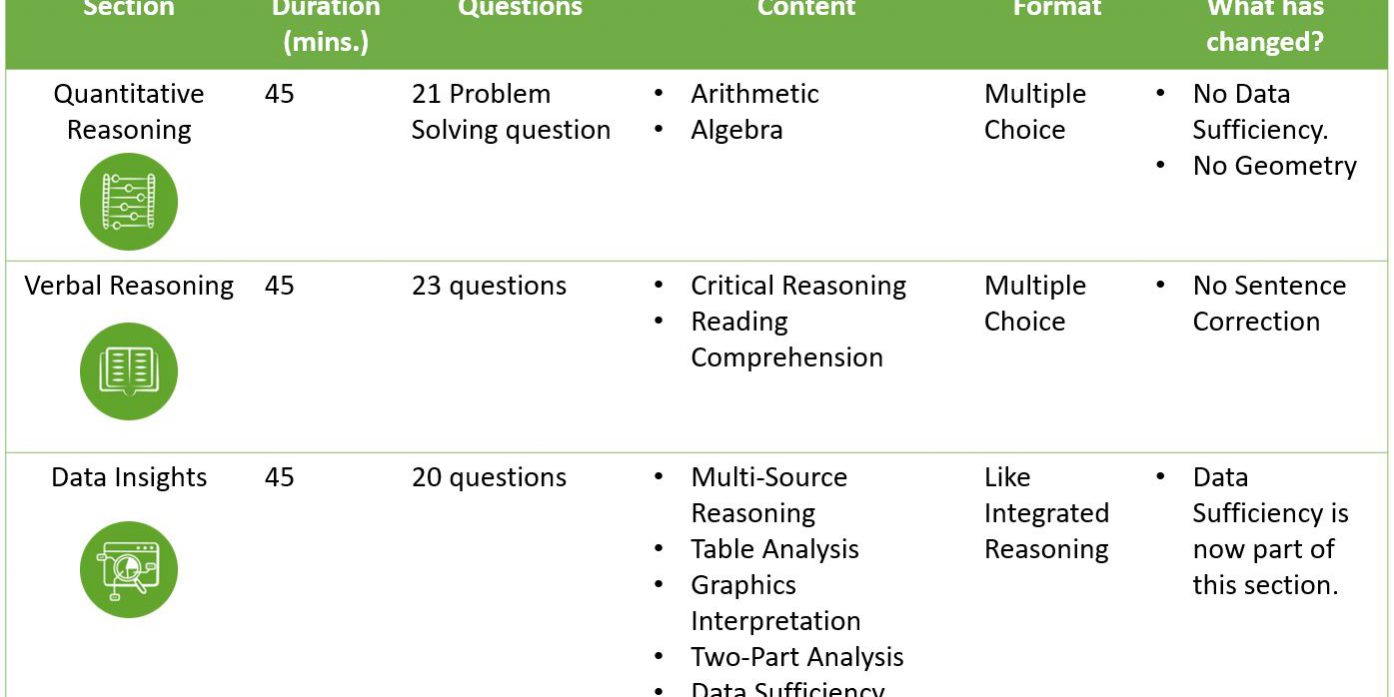The GMAT™ Focus Edition prepares you for graduate business school and beyond by covering content in its three sections relevant to current business challenges and opportunities.
Exam Duration
The exam is only 2 hours, 15 minutes, with only 3 sections, 64 questions, and no writing assessment. Each section is 45 minutes long.
What does the exam cover?
Quantitative Reasoning
New for GMAT™ Focus Edition! This section no longer contains Data Sufficiency questions.
The 21 Problem-Solving questions in this section evaluate your foundational knowledge of arithmetic and algebra, as well as your ability to apply this knowledge to solve problems. To answer these questions correctly, you need to possess some knowledge of basic arithmetic and algebra and must rely on analytical and logical skills rather than just mathematical prowess. This section does not permit the use of a calculator during the test.
Verbal Reasoning
New for GMAT™ Focus Edition! This section no longer contains Sentence Correction questions.
This section evaluates your aptitude for comprehending written material, as well as your ability to analyze arguments and make sound evaluations. The section contains 23 questions, including 23 Reading Comprehension questions and Critical Reasoning questions.
- The Reading Comprehension questions assess your proficiency in understanding words and phrases, identifying logical connections between key ideas, drawing inferences, and tracking the evolution of quantitative concepts. Specifically, the questions will evaluate your abilities in areas such as identifying main and supporting ideas, making inferences, applying concepts, recognizing logical structures, and identifying styles.
- The Critical Reasoning questions gauge your capacity to construct and evaluate arguments and formulate or evaluate a plan of action. These questions are based on a brief passage of usually under 100 words, followed by a question that asks you to identify which of the five answer options strengthens or weakens an argument, explains why the argument is flawed or powerfully supports or weakens the argument. Specialized knowledge of the subject matter is not required to answer these questions.
Data Insights
New for GMAT™ Focus Edition!
The Data Insights section evaluates your capacity to analyze and interpret data and use it to make informed decisions in real-world business scenarios. With the GMAT™ Focus Edition’s updated test design, Data Insights utilizes Integrated Reasoning and Data Sufficiency question types to measure a digital and data literacy dimension that has been newly calibrated, one of the most relevant and sought-after skills in the business world today.
This section consists of 20 questions that assess how you can relate and use multiple sources and types of information, including numeric, graphic, and verbal data, to solve problems. Some questions will require math, data analysis, verbal reasoning, or a combination of all three. You are allowed to use an on-screen calculator during this section.
The types of questions you will encounter in this section are as follows:
- Data Sufficiency: This measures your ability to analyze a quantitative problem, identify relevant data, and determine when there is sufficient data to solve the problem.
- Multi-Source Reasoning: This assesses your ability to analyze data from various sources, including text passages, tables, graphics, or a combination of these, to answer multiple questions. Some questions will require you to recognize discrepancies among different sources of data, while others will ask you to draw inferences or determine whether the data is relevant.
- Table Analysis: This evaluates your ability to sort and analyze a table of data, similar to a spreadsheet, to determine relevant information or meet specific conditions.
- Graphics Interpretation: This measures your ability to interpret graphical information, such as scatter plots, x/y graphs, bar charts, pie charts, or statistical curve distributions, to identify relationships and make inferences.
- Two-Part Analysis: This measures your ability to solve complex problems that may be quantitative, verbal, or a combination of both. The format is intentionally versatile to cover a wide range of content, and it evaluates your ability to evaluate trade-offs, solve simultaneous equations, and recognize relationships between two entities.





